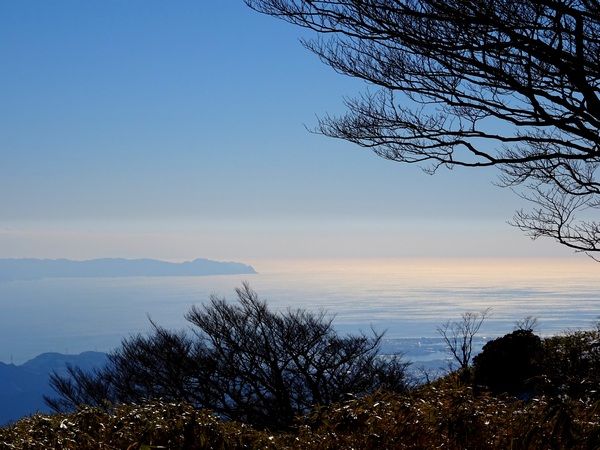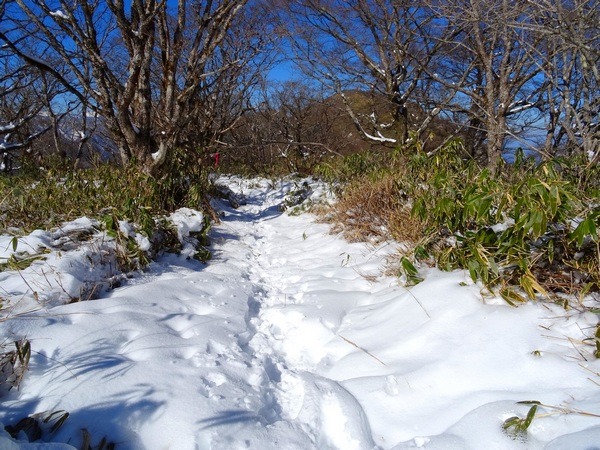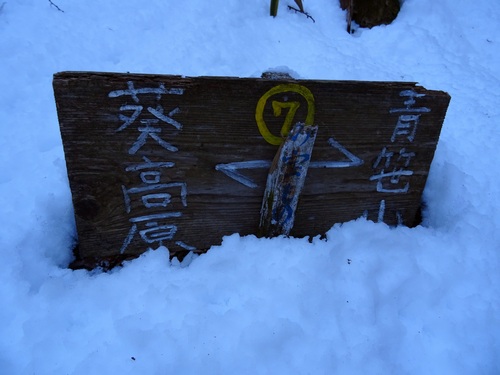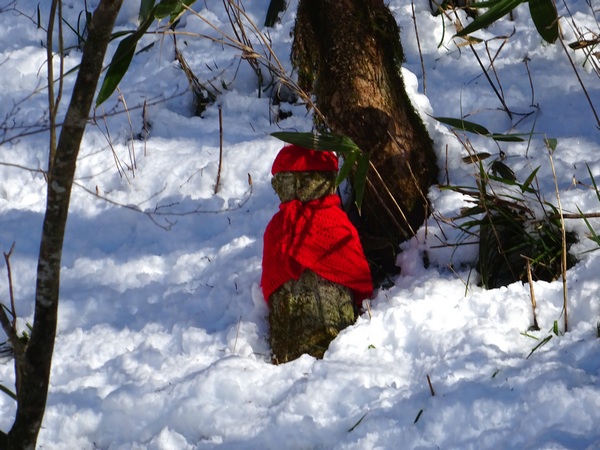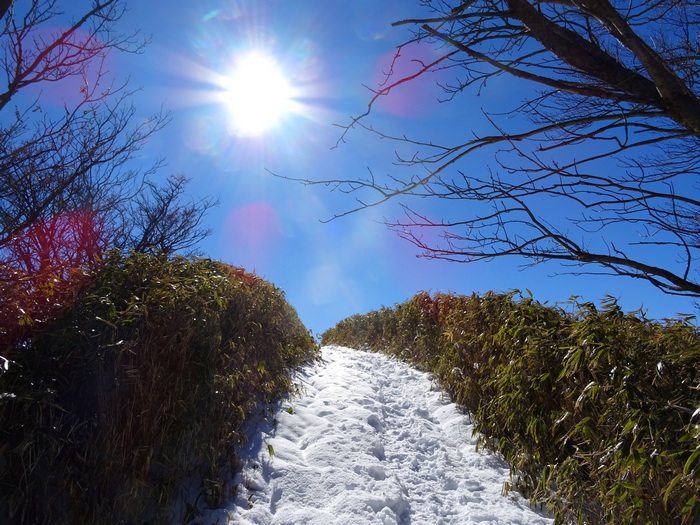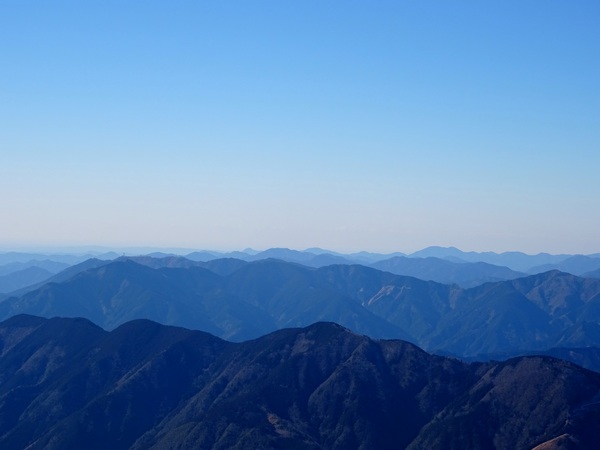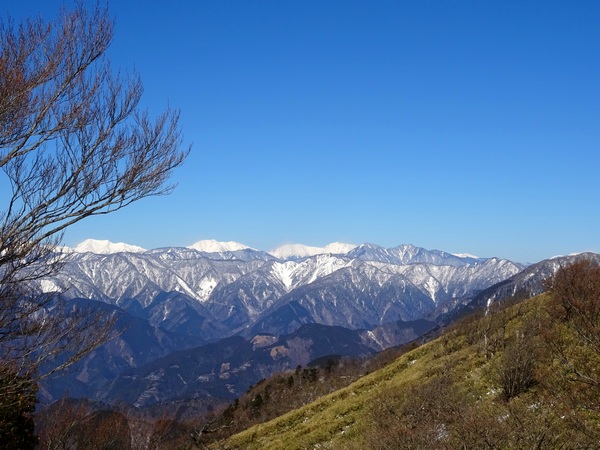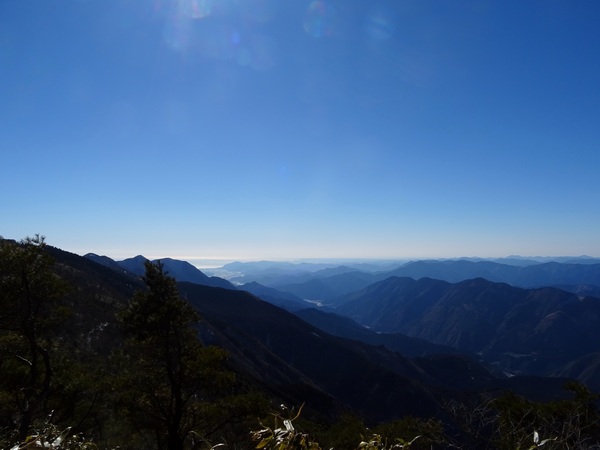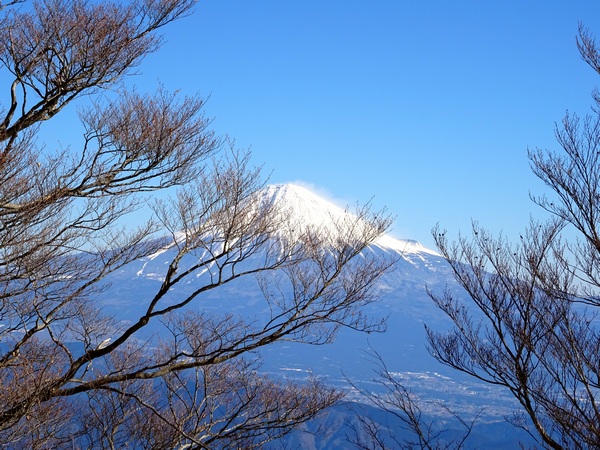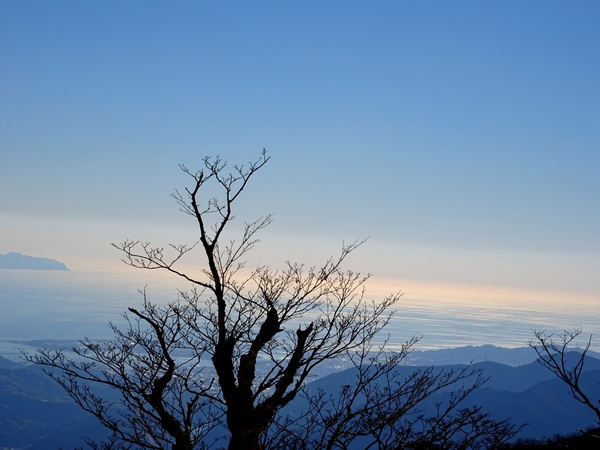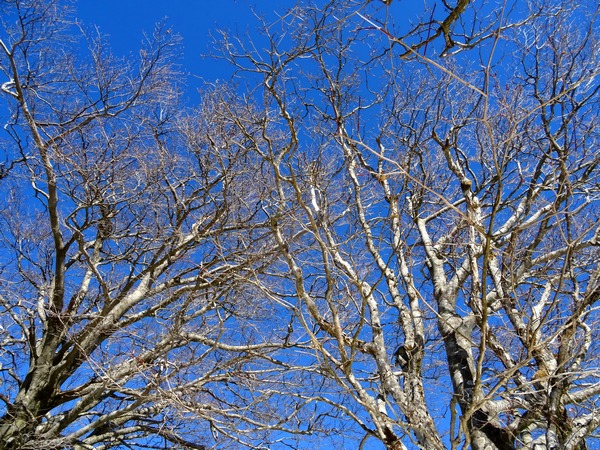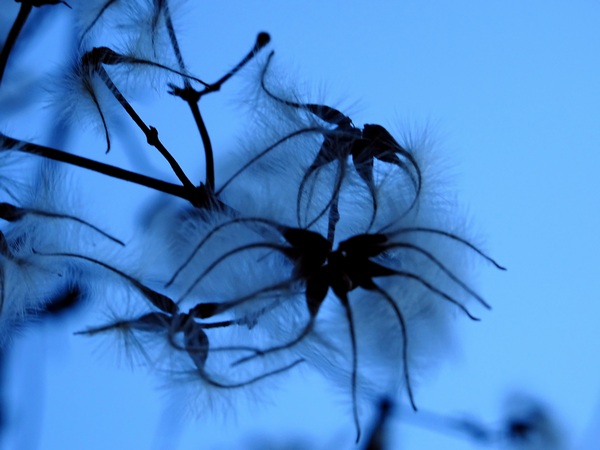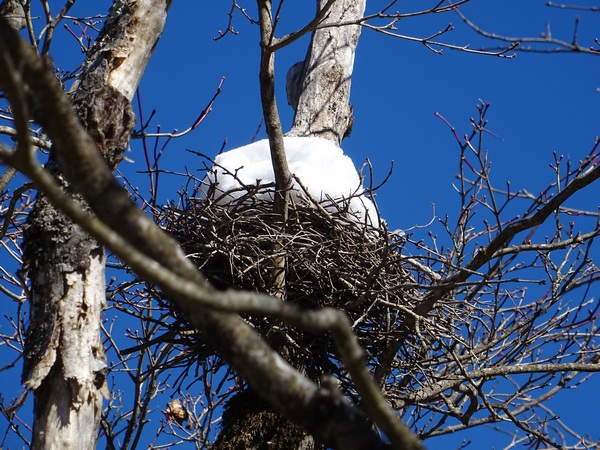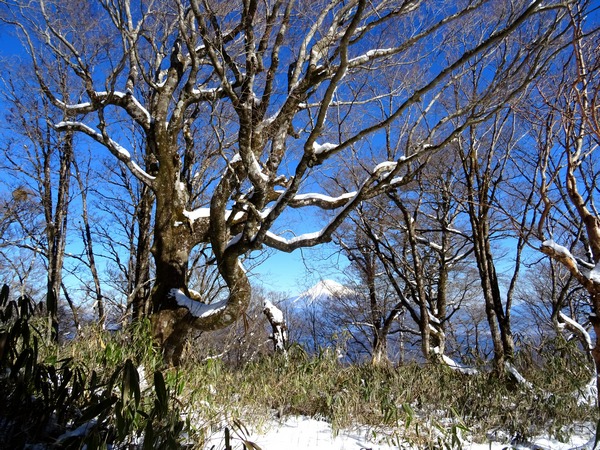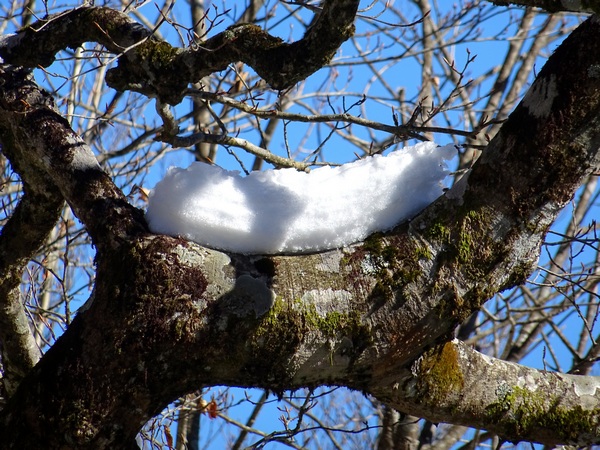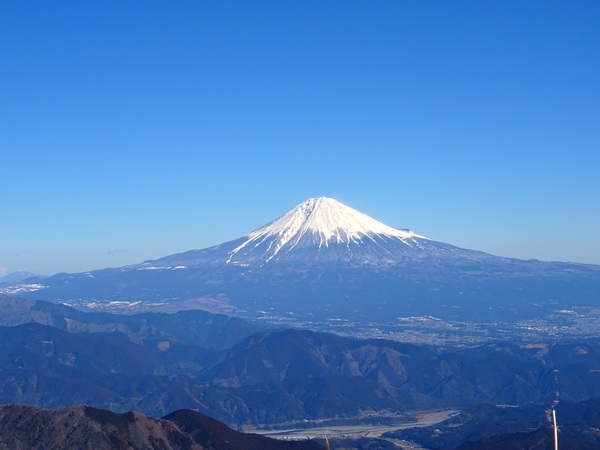It was the most beautiful day ever, but first, before I get to that, I’ll give you some barebone instructions for experiencing it for yourself—what some might call the blog’s “useful” information.
Drive up route 29 from Shizuoka City. About 30 or 40 minutes. Turn right at the big “Utogi” sign. Wind and climb up the winding, climbing road. Park at Aoi Kogen (葵高原). Lock your car. Don’t drop your keys. Head up the road that heads for Mumyo no Toge (無名の峠), otherwise known as the Nameless Pass. (Later, if you become contemplative, you can wonder how a mountain pass can be named the Nameless Pass.) But it is truly there, and so named, so when you get to it, the Nameless Pass (an hour or an hour and a half climb), take a deep breath and enjoy the sudden and stunning view of Mt. Fuji—sometimes known to friends who are quite familiar with him as Fuji-kun. Then make a sharp right turn and walk along the ridge. A half-hour or so later, you’ll get to the top of Aozasa Mountain (青笹山). More on that later. Eat lunch. Sing a song. Walk back the way you came, past the pass named Nameless, then walk the ridge all the way to Jizo no Toge (地蔵の峠). A jizo is a stone statue of a guardian diety. Say hello to Mr. Jizo in his little hut. Leave him some pocket change. Don’t drink his beer. Then turn left and head down the mountain. Hit the road. Follow the road back down to Aoi Kogen. Find your car keys inserted into the lock of your car door. This is not where you left them. You dropped them on the ground. Somewhere. Who knows where? But some kind soul picked them up and put them in a place where you’d be sure to find them. In the lock of your car door. Now it really does become a perfect day for you.
This whole walk will take about six hours–if you take 40 minutes for lunch and you take 212 pictures along the way. (Yes, there were “restroom” breaks but don’t ask about those.)
So that’s that.
Now, what I really want to tell you is . . . well, actually there are lots of things I want to tell you, but the first one is . . .
. . . that this amount of snow is easy and fun to walk in. Really easy. Really fun. We had boot irons in our backpacks but never took them out. It’s not so much snow that . . .
you can’t see the signs. But even if you couldn’t see the signs, the trail itself would remain (barring an unprecedented blizzard) clear and easy to follow, and . . .
Mr. Jizo would always be in the vicinity to guide you and assure your safety.
So that’s the first thing. The second is . . .
a clear day on this mountain, in February, just a few days after a snowfall, will be the most beautiful thing you’ll ever see.
When you get to this stretch of snow, just beneath the summit, you’ll giggle, half embarrassed, wondering why it’s you that’s so lucky to be here, in this place, on this day, with this snow and this sky, with this double hedgerow of bamboo—why you’ve got it, for all practical purposes, all to yourself.
You may find yourself clicking your boot heels, jingling your bear bell, and mumbling, “Follow the silky white road, follow the silky white road.”
Then you’re going to be on the top and you’re going to spin about, arms spread (yes, kind of like Julie Andrews), taking everything in, and you’re going to wonder how ten minutes earlier you could have possibly seen the most beautiful thing ever . . . when you’re seeing it just now.
Go ahead. Take your time. Take it all in. The Alps, the ocean, Fuji City, the pine forest of Miho, Fuji-kun, little puffs of snow blowing off the top of his head, the mouth of the Abe River. Sing your song. Sigh your sighs. Shake your partner’s shoulders and say . . . “There ain’t no need to say nuttin’—is there?”
At least that’s how I think you’ll feel. I could be wrong. It was, though, how I felt.
In awe.
I think I’m using that word correctly. (And afterall, I’d just “followed the silky white road.”)
In The Great Gatsby, Nick retreats from his East-Coast experiment in “making it” in the bond business to his hometown in the Midwest. He tells us that he was so disgusted by the carelessness he witnessed in Tom Buchanan and others, he “wanted the world to be in uniform and at moral attention forever.” I, on the other hand, standing atop Aozasayama, could only think that I myself wanted to stand at moral attention forever—and at attention in the uniform of the universe*—I could only think that I wanted to stand in moral attention to it—it, the universe—in its uniform, forever . . . maybe a little longer.
*The uniform of the universe is, of course, the ultimate uniform: UNI-form + UNI-verse = Ultimate. (That was 10th-grade math, I think.) (I think if you give it even a little bit of thought you’ll see this is how the form of the verses flow.)
Emerson tells us this: “The stars awaken a certain reverence, because though always present, they are inaccessible, but all natural objects make a kindred impression, when the mind is open to their influence. Nature never wears a mean appearance.”
More or less that’s right, but Emerson never stood atop Aozasayama. If he had, I’m pretty sure he would have written, “The blue sky sunshine, the rosy sea, and the puffs of snow blowing of the top of Mt. Fuji awaken a certain reverence because, because, Geez, just look at it all! Take! It! In!” He could have kept the second part of his statement as it is, the part about all natural objects making a kindred impression. That’s dead on. All you need is a blade of grass. Or a spear of bamboo. That’s all you need to search out nature’s secrets—and ultimately to search out the secrets of your own mind. And any man or woman who does that will surely learn that “in going down into the secrets of his [or her] own mind, he [or she] has descended into the secrets of all minds.”
And I kept hearing Georgie’s beautiful voice: Some things take so long / But how do I explain / Not too many people / Can see we’re all the same / And because of all their tears / Their eyes can’t hope to see / The beauty that surrounds them / Isn’t it a pity?
A few days before my hearty hiking partner and I climbed Aozasayama, I received a message from an American friend, sympathizing with me over the death of Kenji Goto. I was living in Japan. Goto was Japanese. For certain, it was very kind of her, but even so, I wasn’t sure how to respond.
Needless to say, butchery needs to be condemned, and when a good man, with a really good heart, dies like this, despite his efforts to bridge cultures, it’s a gut-wrenching tragedy. And even though I’m a dyed-in-the-wool pacifist, so non-confrontational and non-retaliatory in nature so much of the time that I’ve been called the worst of wimps more than a few times in my life, I can see that there’s a time when aggresive force is justified to stop a certain brand of assailant from acting further. This certainly looks like one of those times.
But what I worry about is this: The purpose of all this sadistic “tough guy” behavior is (I think) to leave in awe young men who might be enticed to join the cause if the awe they feel is deep enough. So you can hunt down and kill the direct perpetrators, but unless you make a counter appeal to those young men, unless you can provide them with some vision of themselves living with dignity and respect, a vision of themselves being an equal part of the universe, the seeds for new and even more sadistic groups will remain fertile.
A few years ago, a lot of folks in the West thought it could be no worse than Bin Laden.
Atop Aozasayama, what I felt was this: Divine I am inside and out. And this: Every atom belonging to me as good belongs to you.
I don’t live in the universe. I’m a part of the universe.
The universe is not some blanket that I can pull over to my side of the bed.
Yep, that’s what I felt atop Aozasayama, and it’s what I can feel now, if only I look out on the back stoop and see the tiny buds growing plump on the itsy bitsy yashio tree I have growing in a six-inch-high pot.
So I say: Let’s continue our visit. Let’s continue our walk through the snow.
Once you’ve been possessed by the 360-degree panoramic spirit atop Aozasa Mountain, you’ll find yourself abuzz, super sensitive to everything. You’ll feel how longingly winter branches reach for spring.
You’ll be touched by wispy clouds of cotton orbiting rings of seeds.
You’ll wonder about the birds. Where they’ve been. What they’ve been up to. When they’ll be back. If they’ll need a hand tidying up.
And something about the way snow clings to tree branches will fascinate you . . .
. . . and when your friend tells you that snow clinging like that is nature’s way of manufacturing pillows, you will smile, and even if you don’t believe her (or him), you’ll probably agree that it is nature’s way of suggesting “rest” to you, so that you will notice . . .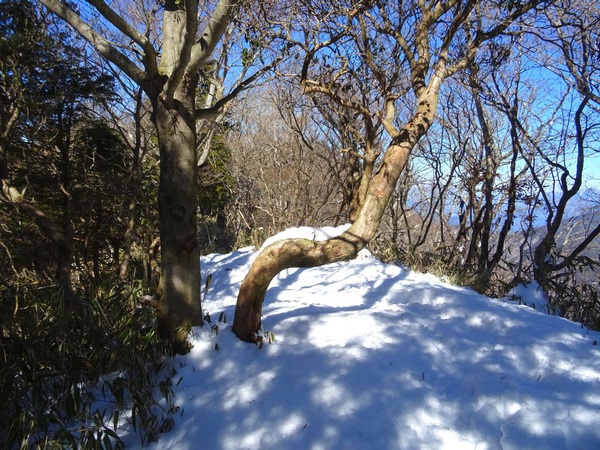
. . . the sitting trees that nature has certainly provided for you (through a long evolutionary process).
And then you’ll be walking down from the Jizo Pass, your boots kicking up a bit of snow, and you’ll still be thinking, “How easy it is to walk through this snow! How nice it is!” Why, you might even start singing about it.
Actually we did. Start singing, that is. Started singing off the tops of our heads about the snow. And fortunately for us (as many of you know), Persimmon Dreams, in an attempt to get people reading, in an attempt to establish greater empathy all around, built a factory with the purpose of manufacturing an extraordinary large number of bookmarks (check the archives). Don’t even get me started talking about all the zeros involved. Anyway, one small area of the factory space was never used, so when we got home that afternoon, we contacted a variety of contractors, and before we knew it, the recording equipment was being hauled in. The buzz attracted all sorts of producers and studio musicians (and agents, too, but we sent them away), and the next thing you know tracks were being mixed and digitally re-mixed and all that sort of stuff . . . and to make a long story short, we are proud here to present to you, at no charge, the first official recording of Persimmon Dreams Studio.
But before you listen (find lyrics and translations below), get off the mountain and find your car keys. Don’t worry about your knees. You’ve been walking in all that forgiving snow. Your knees are fine.
Translation notes: yuki = snow, aruku = walk, yuki ga arukiyasui = snow’s easy to walk in, wo = a grammar marker, don’t worry about it, jizo = stone statue of guardian diety, yashio = azaela-like tree with gorgeous green and red leaves, and in May, lovely white blossoms.
YUKI WO ARUKU
Yuki ga arukiyasui / yuki wo aruku / yuki ga arukiyasui / yuki wo walk with you (me)
Red coat jizo looking good / Welcomes us to the neighborhood
Makes us want to beat the curse / Become one with the universe.
Boots kick snow up from the land / Makes me want to take your hand
Snow blows off of Fuji-kun / Makes me want to kiss you soon.
Chorus
Cedar trees and yashio / Tell us where we need to go
Fighting, feuding have their say / But cannot end our magic day.
High school hikers make the climb / Up step up step feel sublime
Car keys lost who gives a damn? / I know just right where I am.
Chorus
Snow-capped mountains, rosy sea / They tell me what you mean to me
Winter branches reach for spring / They are saying everything
Blue sky sunshine all above / Makes me really feel my love
Diamond snow is all aglow / What else do you need to know?
Chorus
FINIS
